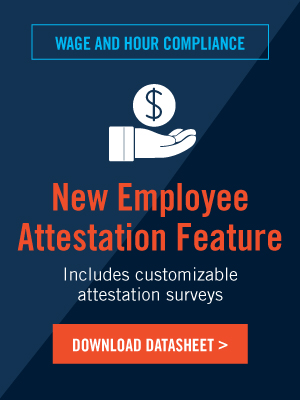Improve Wage and Hour Compliance with Employee Attestation

Seven Steps to Successfully Implement Time Card Attestation
 As we mentioned in our blog last month "Three Employer Wage and Hour Compliance Tips", Wage and Hour issues continue to be on the rise. For employers, finding ways to reduce risk of liability is key. With the progress of workforce management automation technologies, one emerging trend is to implement a Time Card Attestation Clause as part of your time card approval process. There are several ways to build an attestation process, but before introducing an attestation policy, there are some things that need to be done to ensure understanding and adoption by managers and employees so that it can become part of your standard business practices:
As we mentioned in our blog last month "Three Employer Wage and Hour Compliance Tips", Wage and Hour issues continue to be on the rise. For employers, finding ways to reduce risk of liability is key. With the progress of workforce management automation technologies, one emerging trend is to implement a Time Card Attestation Clause as part of your time card approval process. There are several ways to build an attestation process, but before introducing an attestation policy, there are some things that need to be done to ensure understanding and adoption by managers and employees so that it can become part of your standard business practices:
7 areas to address when developing an attestation clause include:
1. Develop the Verbiage:
Determine what you are requiring your employees to attest to: Commonly employers require employees to certify that they have been provided with all the required meal periods and all actual hours worked . An Example clause could be:
“I declare under penalty of perjury that I have accurately recorded all of the hours I worked (including hours outside of my normally scheduled workweek and overtime), I have received all of the meal periods and rest periods, to which I was entitled based on the number of hours I worked, and I have had the opportunity to make any necessary corrections to this time record before I signed it.”
2. Determine the actual business processes needed to implement the new procedure:
Rolling out any new compliance program requires an audit of the existing processes. And the ability to implement a meaningful attestation process will depend on how time cards are collected, submitted, reviewed and stored with the employee history. Simply developing an attestation clause and putting it at the bottom of a paper timesheet may not be sufficient to reduce risk of liability. Are time cards collected manually? Is there a time clock system? Is there a way to monitor missed punches or breaks in real time? Where are historical time sheets ultimately stored.
3. Review employee policies and consistent documentation
Equally important to a streamlined process is your company’s employment documents such as: Employee Arbitration Agreement, Employee Time Record Notice, Notice to Employees, Rest, Recovery and Meal Periods policies, off-the-clock work prohibition policy and all related postings. Auditing these policies and adapting them to be consistent and transparent is critical for adoption. All together, up-to-date employment documents, attestation, and a current employee handbook can be your company’s best defense against employee claims
4. Develop disciplinary practices for frequent abusers of meal, rest periods, overtime and time card / time punch policies:
Utilize progressive discipline in line with your current and past practices for other similar violations.
5. Investigate refusals and frequent policy:
Be sure your business practices allow for adequate time to take meals, breaks and that the work environment does not create the assumption that the employee should work off the clock. Provide an escalation process for supervisors to initiate an investigation.
6. Have a procedure in place to address an employee refusal to attest:
Make sure the manager informs HR to investigate the situation. The employee may need an additional opportunity to ask questions or address a specific concern. This is normal when introducing any new policy. Do not take adverse employment action against the employee after making such complaint without an opportunity to remediate. This will avoid the appearance of retaliation for the complaint.
7. Train managers:
Managers should be aware of the actual policy and how to introduce attestation processes to the employees and be able to address general employee questions or concerns.
Automated Time keeping simplifies attestation collection, management and history:
The OnePoint Time and Labor Module can be configured for electronic Disclaimers and Notification. Time sheet automation provides managers and employees involved in approving time cards with elicit open communications regarding exceptions to the employee's normally scheduled hours, meals and rest periods.
Our Unified HCM platform also ensures that employees have 24/7 access to workplace policies, procedures and the handbook and stores the “reviewed” sign-off on their employee record providing proof that they have been presented and reviewed the documents for added compliance security.
Of course if you aren’t using an automated time keeping system or Attestation Features, companies have the option to simply print approved verbiage on manual time sheets or time cards and have employees manually sign each pay period. This will suffice if you have addressed the 7 areas above to support manual attestation.
Employer Wage and Hour Compliance Responsibilities
No matter what policies and practices you put in place to prohibit unapproved overtime and work outside of the employee's normally scheduled work shift, ALL time must be recorded and the employee must be compensated for that time. Failure to compensate the employee would violate federal wage and hour laws (as well as most state laws).
Consult with an experienced HR Professional or Employment Law attorney prior to terminating an employee for continued violations of these policies. Even if you have adequate progressive discipline documentation, an attestation clause and necessary policies to express wage and hour compliance practices, the risk of a termination on this basis could still be risky of a wage/hour or retaliation claim.
Subscribe to updates
Get the latest posts delivered to your inbox.